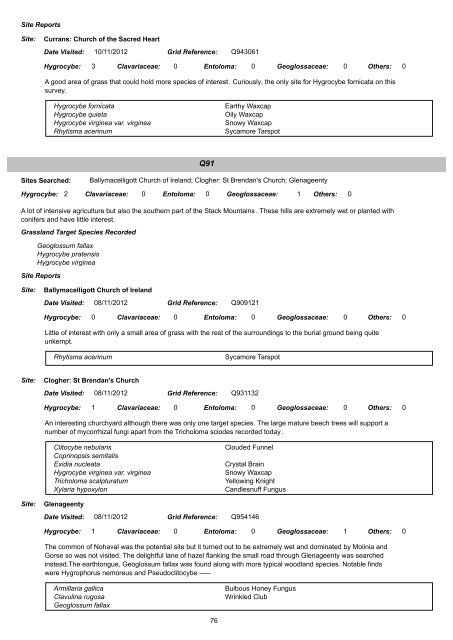North Kerry Waxcap Survey 2012 - the Northern Ireland Fungus Group
North Kerry Waxcap Survey 2012 - the Northern Ireland Fungus Group
North Kerry Waxcap Survey 2012 - the Northern Ireland Fungus Group
Create successful ePaper yourself
Turn your PDF publications into a flip-book with our unique Google optimized e-Paper software.
Site Reports<br />
Site: Currans: Church of <strong>the</strong> Sacred Heart<br />
Date Visited: 10/11/<strong>2012</strong><br />
Grid Reference: Q943061<br />
Hygrocybe:<br />
3<br />
Clavariaceae:<br />
0<br />
Entoloma:<br />
0<br />
Geoglossaceae:<br />
0<br />
O<strong>the</strong>rs: 0<br />
A good area of grass that could hold more species of interest . Curiously, <strong>the</strong> only site for Hygrocybe fornicata on this<br />
survey.<br />
Sites Searched:<br />
Hygrocybe fornicata Earthy <strong>Waxcap</strong><br />
Hygrocybe quieta Oily <strong>Waxcap</strong><br />
Hygrocybe virginea var. virginea Snowy <strong>Waxcap</strong><br />
Rhytisma acerinum Sycamore Tarspot<br />
Q91<br />
Ballymacelligott Church of <strong>Ireland</strong>; Clogher: St Brendan's Church; Glenageenty<br />
Hygrocybe: 2 Clavariaceae: 0 Entoloma: 0 Geoglossaceae: 1 O<strong>the</strong>rs: 0<br />
A lot of intensive agriculture but also <strong>the</strong> sou<strong>the</strong>rn part of <strong>the</strong> Stack Mountains . These hills are extremely wet or planted with<br />
conifers and have little interest.<br />
Grassland Target Species Recorded<br />
Geoglossum fallax<br />
Hygrocybe pratensis<br />
Hygrocybe virginea<br />
Site Reports<br />
Site: Ballymacelligott Church of <strong>Ireland</strong><br />
Date Visited: 08/11/<strong>2012</strong><br />
Grid Reference: Q909121<br />
Hygrocybe:<br />
0<br />
Clavariaceae:<br />
0<br />
Entoloma:<br />
0<br />
Geoglossaceae:<br />
Little of interest with only a small area of grass with <strong>the</strong> rest of <strong>the</strong> surroundings to <strong>the</strong> burial ground being quite<br />
unkempt.<br />
Rhytisma acerinum Sycamore Tarspot<br />
Site: Clogher: St Brendan's Church<br />
Date Visited: 08/11/<strong>2012</strong><br />
Grid Reference: Q931132<br />
Hygrocybe:<br />
1<br />
Clavariaceae:<br />
0<br />
Entoloma:<br />
0<br />
Geoglossaceae:<br />
0<br />
0<br />
O<strong>the</strong>rs: 0<br />
O<strong>the</strong>rs: 0<br />
An interesting churchyard although <strong>the</strong>re was only one target species. The large mature beech trees will support a<br />
number of mycorrhizal fungi apart from <strong>the</strong> Tricholoma sciodes recorded today .<br />
Clitocybe nebularis Clouded Funnel<br />
Coprinopsis semitalis<br />
Exidia nucleata Crystal Brain<br />
Hygrocybe virginea var. virginea Snowy <strong>Waxcap</strong><br />
Tricholoma scalpturatum Yellowing Knight<br />
Xylaria hypoxylon Candlesnuff <strong>Fungus</strong><br />
Site: Glenageenty<br />
Date Visited: 08/11/<strong>2012</strong><br />
Grid Reference: Q954146<br />
Hygrocybe:<br />
1<br />
Clavariaceae:<br />
0<br />
Entoloma:<br />
0<br />
Geoglossaceae:<br />
1<br />
O<strong>the</strong>rs: 0<br />
The common of Nohaval was <strong>the</strong> potential site but it turned out to be extremely wet and dominated by Molinia and<br />
Gorse so was not visited. The delightful lane of hazel flanking <strong>the</strong> small road through Glenageenty was searched<br />
instead.The earthtongue, Geoglossum fallax was found along with more typical woodland species. Notable finds<br />
were Hygrophorus nemoreus and Pseudoclitocybe -----<br />
Armillaria gallica Bulbous Honey <strong>Fungus</strong><br />
Clavulina rugosa Wrinkled Club<br />
Geoglossum fallax<br />
76


